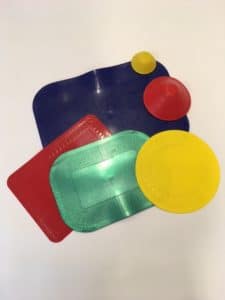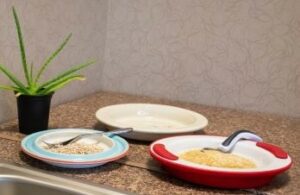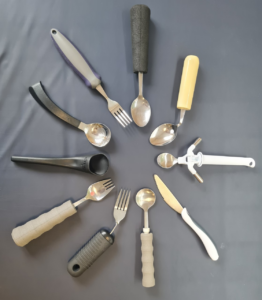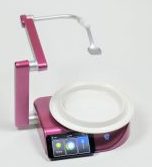If weakness, reduced range of movement, or tremor has made eating and drinking difficult, come see our Therapists at the ILC for advice. The first thing we will want to know is how and where you like to eat and drink. If you sit in an armchair, a dining chair, or a wheelchair, we will look at ways to create a stable and functional seated position. We will look at the right seat height for you and try out supports within the chair to help you achieve the most stable and functional position for eating and drinking. We will also look at the ideal position of the table, your plate, cup and cutlery. When you are in a better position for eating and drinking then ordinary cutlery and crockery may be easier to use, but you can also try equipment from our display of specialist cutlery and equipment.
where you like to eat and drink. If you sit in an armchair, a dining chair, or a wheelchair, we will look at ways to create a stable and functional seated position. We will look at the right seat height for you and try out supports within the chair to help you achieve the most stable and functional position for eating and drinking. We will also look at the ideal position of the table, your plate, cup and cutlery. When you are in a better position for eating and drinking then ordinary cutlery and crockery may be easier to use, but you can also try equipment from our display of specialist cutlery and equipment.
Over chair tables may be useful if you have no choice but to stay in an armchair, wheelchair, or bed when eating or drinking. It is important to get the table at the right height and close enough to you so that you can be in the best functional position when eating from an over chair or over bed table.
Non-slip mats are useful to stabilise the plate on the tray or table so that you can cut or scoop without the plate moving. We have round and rectangular mats here and even non-slip matting on a roll that can be cut to size.

Larger handles may make cutlery easier to grip and you can try out a range of different sized handles for your knives and forks including ranges from cura cutlery and Good grips. Unfortunately, we can’t offer you a real meal to test the cutlery, but we use playdough to mimic food, so that you can cut and scoop to find what shape handle works for you.
Rocker knives make cutting easier as the knife rocks over the food unlike traditional knives that use a sawing action. You can try these at the Independent Living Centre and see how the rocking cutting action holds food in place. We also have knives with ergonomic handles which are easier to use if your hand or wrist is weak or painful.
Angled spoons and forks may help you to bring the food to your mouth if you have limited movement in your shoulder or arm, but the angle may make scooping more difficult. It is good to try both of these and see if the angled cutlery is useful for you.
Weighted cutlery is designed to assist people who have a tremor, some people find this feature helpful. You can come and try these for yourself and we can also explore other options to help you eat safely and independently.
The cutlery strap holds the spoon or fork in your hand without the need to grip. This helps if you cannot sustain a secure grip while eating and sometimes this strap also supports someone with a tremor.
A stabilising handle on the table may work for you as you can hold it to support yourself in a stable position, leaving your other arm and hand to do the finer movements required for holding and using cutlery – like this one from Smirthwaite.


See our ‘Technology for Eating & Drinking‘ equipment advice for information about assistive technology.